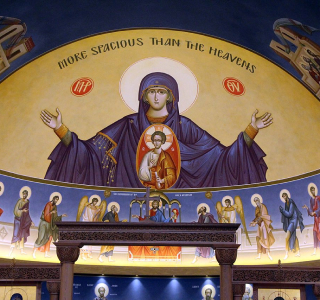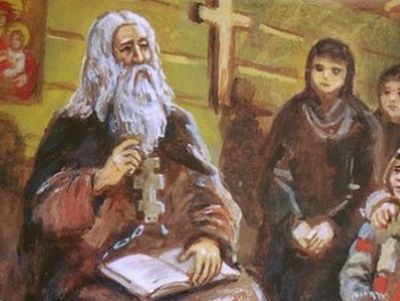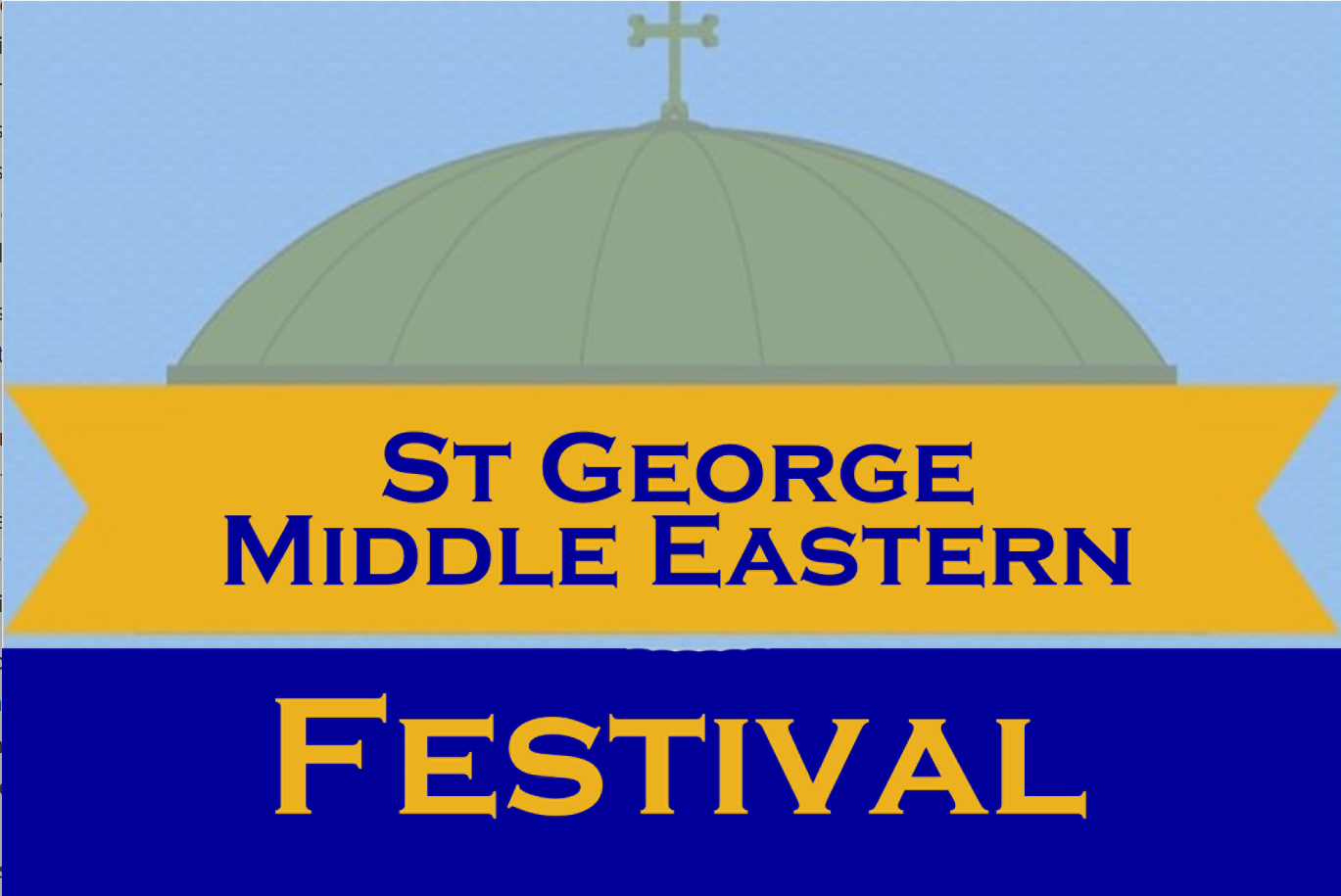Visit us
Our Schedule of Worship
Sunday – Matins
8:50 AM
Sunday – Divine Liturgy
immediately following Matins
Wednesday – Vespers
6:30 PM
Saturday – Great Vespers
5:00 PM
St George Experience
The parish family of St George invites you to experience the worship of the Orthodox Church, the outreach and charitable ministry of Christ’s Holy Church and the hospitality and fellowship of the faithful of St George. Christian Education for adults and youth are an integral part of our community. Our annual Festival (held in September) is one of our primary connections to the greater community of Fishers, Hamilton County and Indianapolis.
Directions/Map
Faq
The Orthodox Church is evangelical, but not Protestant. It is orthodox, but not Jewish. It is catholic, but not Roman.It isn’t non-denominational – it is pre-denominational. It has believed, taught, preserved, defended and died for the Faith of the Apostles since the Day of Pentecost 2000 years ago.
Just as our Lord welcomed all, so do we gladly receive all who wish to be with us in our worship of God in the Divine Liturgy. No one should feel intimidated or uncomfortable while worshiping the Lord, and we freely welcome anyone who wishes to join with us in our services.
When you first arrive you will probably think you have come late, even though you may have come in several minutes before the Liturgy is to begin. That is because in the Orthodox Church there are services called Matins that occur during the hour preceding the Liturgy. Matins consists mainly of prayers and readings that are designed to help participants focus on the worship ahead. There is no pause between the end of Matins and the beginning of the Liturgy, but once the Liturgy begins (almost always precisely at 10:00 in our parish) you should have no difficulty following along, especially if you have a service book. Orthodox worship is extremely focused on God and the Holy Trinity, and the service itself is slightly longer than those in many Western churches. The earliest known Liturgy lasted about five hours (!), but around A.D. 400 St. Basil edited it down to about half that. St. John Chrysostom later reduced it down even more, to about one and a quarter to one and a half hours. Most Sundays St. George uses the Liturgy of St. John Chrysostom, so the Liturgy generally concludes between 11:15 and 11:30.
Because the Orthodox Church views Communion (or the “Eucharist” as it is more commonly known) as the Body and Blood of Christ and not as a mere memorial, it is treated with greater gravity than it is in many other churches. Because of this, the Church may only distribute the Eucharistic elements to faithful Orthodox believers. This is not meant to offend or ostrasize those of other faiths, since even some Orthodox will not come forward for Communion if they have not made regular confession or feel they have not prepared themselves properly to receive the Holy Gifts. However, although non-Orthodox may not participate in the Eucharist itself, everyone is welcome to come forward for the blessing at the close of the Liturgy and receive some of the blessed bread (called antidoron). The antidoron is not that which has been consecrated and mystically changed into the Body of Christ, but is merely bread that has been blessed by the priest which may be received by all as a sign of fellowship. You may even be offered some of the antidoron by an Orthodox worshipper as he or she returns from receiving the Eucharist. Feel at ease accepting it as a token of our appreciation for your presence with us.
The Orthodox Church is the oldest Christian Church and is the Church of the Lord Jesus Christ, founded upon the teachings of the Holy Apostles. It is the Church that received the promised Holy Spirit at Pentecost in A.D. 33/34. It is also the Church out of which came the writings of the New Testament. All other mainstream Christian churches can trace their origins historically back to the Orthodox Church. It is the second largest Christian body in the world with approximately 225 million members worldwide, of which nearly six million live in the United States and Canada.
Excepting a few churches of modern invention that have incorporated the word “orthodox” into their names but bear no relationship to the ancient Church, there is not the kind of division within Orthodoxy as one finds among the various Protestant denominations. Although one can look about and see names like Greek Orthodox, Russian Orthodox, Antiochian Orthodox, Serbian Orthodox, and so on, these do not represent different faiths within Orthodoxy. They all are names for one and the same Orthodox faith and practice. There are some cultural differences among these various Churches, but these differences do not touch on the essence of faith. Just as St. John was asked to address seven different churches in the Book of Revelation, those churches were named because of their geographical locations. Certainly each of the seven churches maintained some slightly different cultural customs or even different languages, but they all were part of the One True Church of the New Testament. In the same way, all the various Orthodox Churches today simply comprise the One, Holy, Catholic, and Apostolic Church of the first century.
Historically, the Pope was recognized on a collegiate level as the Patriarch of Rome and as “first among equals” with the other Bishops and Patriarchs. But since the Schism of 1054 when the Pope attempted to assume supreme authority over the entire Church, Orthodoxy cannot honor that claim. Nor does the Orthodox Church acknowledge other innovations of the Roman Church such as papal infallibility, indulgences, purgatory, or the doctrine of the immaculate conception. These were all later additions to Christian doctrine and practice and are not part of Orthodox dogma
If you are coming from a non-Orthodox background, you will probably see the Divine Liturgy as very “different.” But what is important to remember is that it is not Orthodoxy that is different, but that it is the Western churches that have introduced new and different traditions of worship over time. Orthodoxy endeavors to hold fast to the Apostles’ doctrine, and we retain the form of worship of the early Christians which is called “liturgical.” This means that we follow a liturgy, a word meaning in Greek “the work of the people.” While the service is presided over by a priest, it is co-celebrated by all the people as one Body. Service books are available to the right just inside the narthex (main entrance). Please feel free to take and use one through the Liturgy.
To your right as you enter the narthex you may see people lighting candles before icons of our Lord. Candles play an historic role in the Orthodox Church. Though candles were originally used as a means of lighting, the symbolism of the light of many candles to represent how we as Orthodox Christians are to allow Christs light to shine in our own lives remains extant in our worship to the present day.
Once you enter the sanctuary you will see many icons. These are pictorial representations of Christ, the Holy Theotokos (the Virgin Mary, the Mother of our Lord), and of the Holy Saints and Apostles. Orthodox Christians do not worship these images, but we do venerate them to show honor to those whom the icons represent. In a way this is something like the honor an American may show to the flag of the United States when he salutes it or places his hand over his heart during the national anthem. It is not worship (for worship belongs to God alone) but is a sign of respect and honor. In similar fashion we honor the Saints who have helped guide us by demonstrating the Christian walk in their lives while here on earth.
The important thing to remember is that you should do only that with which you are comfortable. You will not offend anyone if you choose not to venerate icons, cross yourself, or stand for the entire Liturgy. (Orthodox Christians stand during most of their worship.) None of these things are requirements, even for the Orthodox, and should you feel uncomfortable participating, simply stand or sit reverently and observe. Many Orthodox converts have been exactly where you are, and no one will feel affronted should you wish to limit your participation in the Liturgy to simply watching and listening.
Because the worship itself in the Divine Liturgy is so focused on God, we do not use this time of corporate worship to spend visiting with friends and neighbors. Sometimes outsiders get the impression that the Orthodox don’t care much about visitors, but this is entirely incorrect. Visitors are always welcomed and are encouraged to remain at the parish for coffee hour immediately following the Liturgy. This is the time for socializing and greeting one another on a personal level. Be sure to stay for at least a few minutes in the social hall after the Liturgy so that we can meet you and answer any questions you might have.
In the true meaning of the word, the Orthodox Church is the “One, Holy, Catholic, and Apostolic Church” of the New Testament. Here the word “catholic” is used in its original sense of something that is “whole, universal, not confined to one area.” But in the common understanding of the word “Catholic” (meaning “Roman Catholic”), the Orthodox Church is neither Catholic nor Protestant.
To better understand this, it is necessary to comprehend the timeline of Church history. For roughly the first thousand years of the Church’s existence, there was but one Church — the Orthodox Church. Indeed, the word “orthodox” means straight or correct teaching. Though there were various heresies that the Church encountered throughout its early history, the Church itself held to the “straight path,” or to Christian orthodoxy. It wasn’t until the year 1054 when the Roman Church separated itself from the path of Orthodoxy that there existed any major division within the Body of Christ on earth. But after leaving the True Path, Roman Catholicism itself later began to experience through the Protestant Reformation the same kind of division it originally visited upon the One Church. Most of the early Reformers (and many who followed after them) had become disenchanted with the direction the Roman Church had taken, and these great men of faith made valiant efforts to return to the True Path of the Christian faith. But having been separated from Orthodoxy for 500 years or more, many of these Protestant leaders in the West were not even aware that the Church in the East had maintained the original doctrines of the Church since the beginning. While we applaud the noble efforts of many men and women of faith through these centuries, they did not return fully to the original Orthodoxy the Western Church had left centuries before.
To someone looking at Orthodoxy from the outside, it might appear that Orthodoxy is closer to Catholicism than to Protestantism. But this assumption would be based principally on the externals of Orthodox worship. Because Roman Catholicism came directly out of Orthodoxy, it retains some of the same outward forms that were present in the ancient Church, particularly in the area of corporate worship. But in truth, as one nineteenth-century Russian theologian described it, the Catholic and Protestant churches have more in common with one another than either do with Orthodoxy. Because Orthodoxy is the original Church, it must be examined on its own merits and not so much in comparison with other faiths.
In a short introduction such as this, it is impossible to delve into the rich depths of Orthodox belief and practice. At its core, however, the true faith of the Orthodox believer can be summarized in the Nicean-Constantinopolitan Creed:
I believe in one God, the Father Almighty, Maker of heaven and earth, and of all things visible and invisible;
And in one Lord Jesus Christ, the Son of God, the Only-Begotten, begotten of the Father before all worlds, Light of Light, True God of True God, begotten, not made; of one essence with the Father; by whom all things were made: Who for us men and for our salvation came down from heaven and was made incarnate of the Holy Spirit and the Virgin Mary, and was made man; And was crucified also for us under Pontius Pilate, and suffered and was buried; The third day He rose again, according to the Scriptures; And He shall come again with glory to judge the living and the dead; Whose kingdom shall have no end.
And I believe in the Holy Spirit, the Lord and Giver of Life, Who proceeds from the Father, Who with the Father and the Son together is worshiped and glorified, Who spoke by the prophets.
And I believe in One Holy Catholic and Apostolic Church. I acknowledge one Baptism for the remission of sins. I look for the resurrection of the dead and the Life of the world to come. Amen.
This statement represents the essence of Orthodox Christianity and is perhaps the greatest articulation of the Christian faith ever devised. In it we find our theology and the foundation of our doctrine defined in every detail. So important is this statement of faith that all Orthodox Christians recite it at every Divine Liturgy, and most incorporate it in their daily prayers and devotions at home.
In regards to all other Orthodox beliefs, the New Testament and the Creed are thoroughly consistent with the life and practice of the Holy Church. Unlike many churches of today that have embraced liberal theology and deny the authority of Holy Scripture, Orthodoxy reveres the Bible as the Holy Word of God. But we do not hold the Bible in a vacuum — it is God’s Word that was given to the world through the Church, and it is within the Church (which is indwelt by the Holy Spirit) that we must interpret Scripture. This does not mean, of course, that the Church can manipulate Scripture to make it say whatever it wants; but it does mean that we believe the only way to interpret Scripture properly is through the eyes and understanding of the Holy Church and the Apostles, Saints, and martyrs who have lived it throughout the ages. In light of that, the Orthodox Church does not see a need to choose between Scripture and Tradition, for we accept both Scripture and Tradition since Scripture itself teaches us to “hold the traditions which you were taught, whether by word or our epistle” (II Thessalonians 2:15). Our Holy Traditions are as much a part of our Christian walk as are the Holy Scriptures, for they do not contradict but rather complement each other.
Orthodoxy looks kindly on all who seek the way of God, and it does not deny that many great men and women of faith have contributed notable and beneficial things to a dark and sinful world in search of the light of God’s truth. And while the Orthodox Church believes that it is the One, True Church, this does not mean that it believes all other churches are utterly without Grace. What it does mean is that it believes no other church can claim the fullness of Christ’s Church. This fullness can be found only in Orthodoxy. After all, the Orthodox Church is the original Church instituted by Christ Himself and has maintained the teachings of the Apostles since the earliest days. Where else can one go to find a similar claim? Truth may indeed be found in many Christian denominations, but the whole truth rests in Holy Orthodoxy.









